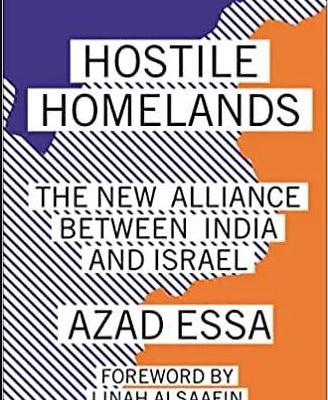Hostile Homelands: The New Alliance Between India and Israel

Book Author(s) :Azad Essa
Published Date :March 2023
Publisher :Pluto Press
ISBN-13 :97806745345017
Azad Essa’s book, Hostile Homelands: The New Alliance Between India and Israel (Pluto Press, 2023), offers detailed insights into the politics of Zionism and Hindutva. With an introduction by Linah Alsaafin, the reader is introduced to India as a purported supporter of Palestine “contingent on Israeli interests”. Zionism and Hindutva, which shape Israel and India respectively, share historical similarities. For Vinayak Savarkar, who developed the Hindutva ideology, Zionism was a model to emulate. “If the Zionists’ dreams are very realised – if Palestine becomes a Jewish state – it will gladden us almost as much as our Jewish friends,” Savarkar wrote in the 1920s.
Drawing upon both ideologies, Essa illustrates how India’s foreign policy shifted from drawing comparisons between Palestine and India as a result of British colonialism, to recognising Israel in 1950. As part of the UN Special Committee on Palestine, India opposed the 1947 Partition Plan and called for a federal solution. Yet, Essa notes, India’s politics and policies later showed extensive collaboration with Israel, particularly in security and counter-terrorism, as well as its annexation policies in Kashmir. India purchased weapons from Israel in 1962 and military cooperation continued in 1963. The 1967 war, which resulted in Israel’s military Occupation of Palestine, as well as Israel expanding its military industrial complex, India maintained diplomatic relations with Israel and Palestine, establishing a duplicitous stance of rhetorically and publicly supporting Palestine, while privately dealing with Israel. Full diplomatic relations with Israel were established in 1992, with the blessings of Yasser Arafat, leader of the Palestine Liberation Organisation.
Essa writes how, after the Cold War and the dissolution of the Soviet Union, India sought to establish relations with the US through Israel and integrate the country to a capitalist economy. With its overtures to the US, India “could simultaneously trade in weapons and surveillance technologies with Israel, while remaining “‘a friend’ to the Palestinians because of its purported commitment to the question of Palestine in occasional words of support, charity and votes at the UN.” Between 2003 and 2013, India was Israel’s largest buyer of weapons – Essa notes that India’s purchases surpassed supplies to the IDF at some point in this timeframe.
Essa notes other similarities, such as the rise of ethnocracy in India, which Zionism accomplished through the Judaisation of Palestine since the 1948 Nakba. British colonialism, of course, is the major factor. “The question of Palestine, after all, and the dispute in Kashmir, emerged from the ashes of British colonialism,” Essa writes.
One important discussion in the book is how the Israeli and Indian lobby influence US foreign policy. The American Israel Public Affairs Committee (AIPAC) has exerted its influence in the US since the 1960s, and Hindu nationalists modelled their lobby on the Zionist structure. While AIPAC is, undoubtedly, the most influential Zionist lobby, Essa notes how vast Zionist influence is in the US, including among those who argue against the military Occupation, while defending Israel’s so-called right to exist.
Hindu nationalist organisations in the US portrayed themselves as representatives of a new Hindu India and sought to make Hindutva synonymous with the country, resulting in investments in the US which, in turn, created a new identity of the “Indian” that was supported by various industries and cultural institutes.
Similarly to Zionism, Hindutva proposed Hinduism as the identity of the future Indian state in the 1924 publication of “Essentials of Hindustava”. Essa quotes Palestinian writer, Edward Said – “the concealment of Zionism of its own history has by now become institutionalised and not only in Israel”, to portray how Hindutva in India created structures related to caste, hierarchy and power. Education also played a role in altering India’s history even up to tertiary education – a move which Israel also adopts in its curriculum and erasure of Palestinian history and memory.
Like Israel’s portrayal by the West, India is also upheld as peaceful and its human rights track record ignored in order to promote the labour market in the country in terms of cutting labour costs for multinational corporations. Post 9/11, Essa writes, “Palestine and Kashmir are targets of the exclusionary, ethno-nationalist ideologies of Zionism and Hindutva that seek their eradication.” Both Israel and India use the military, surveillance technology, restrictions on free movement, checkpoints and collaboration to keep the populations subjugated. As Zionism deprives Palestinians of their land, the Indian government, in 2020, allowed Indian citizens to purchase land in Kashmir, while eviction of indigenous communities in Kashmir, as with Palestinian Bedouin communities in the Naqab, is also another feature of the exclusionary racist policies adopted by India.
While the similarities are not meant to merge the unique experiences of both India and Palestine under Israel’s colonial military Occupation, Essa sheds light on the intricacies of foreign policies in terms of Zionist influence and how vast its reach is, as well as the connections between India and Israel and their methods of oppression. Allowing much space for critical reflection, Essa’s book is a vital read.
https://www.middleeastmonitor.com/20230307-hostile-homelands-the-new-alliance-between-india-and-israel/
 TheAltWorld
TheAltWorld 
0 thoughts on “Hostile Homelands: The New Alliance Between India and Israel”